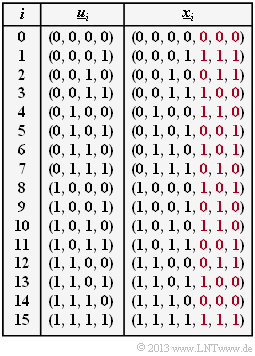Exercise 1.13Z: Binary Erasure Channel Decoding again
We consider as in the "Exercise 1. 13" the decoding of a "Hamming Codes" after transmission over an erasure channel ⇒ "Binary Erasure Channel" $\rm (BEC)$.
The $(7, 4, 3)$-Hamming code is fully described by the adjacent code table $\underline{u}_{i} → \underline{x}_{i}$ which can be used to find all solutions.
Hints:
- This exercise belongs to the chapter "Decoding of Linear Block Codes".
- In contrast to "Exercise 1.13" the solution is here not to be found formally, but intuitively.
Questions
Solution
(2) The first $k = 4$ bits of each code word $\underline{x}$ match the information word $\underline{u}$. Correct is therefore YES.
(3) If no more than $e_{\rm max} = d_{\rm min}- 1 \ \ \underline{ = 2}$ bits are erased, decoding is possible with certainty.
- Each code word differs from every other in at least three bit positions.
- With only two erasures, therefore, the code word can be reconstructed in any case.
(4) In the code table, one finds a single code word starting with "$10$" and ending with "$010$", namely $\underline{x} = (1, 0, 0, 1, 0, 1, 0)$.
- Since this is a systematic code, the first $k = 4$ bits describe the information word $\underline{u} = (1, 0, 0, 1)$ ⇒ answer 2.
(5) Correct are the suggested solutions 1 and 2.
- $\underline{y}_{\rm D} = (1, 0, {\rm E}, {\rm E}, {\rm E}, {\rm E}, 0)$ cannot be decoded because less than $k = 4$ bits (number of information bits) arrive.
- $\underline{y}_{\rm C} = ( {\rm E}, {\rm E}, {\rm E}, 1, 0, 1, 0)$ is not decodable because $\underline{x} = (0, 1, 1, 1, 0, 1, 0)$ and $\underline{x} = (1, 0, 0, 1, 0, 1, 0)$ are possible outcomes.
- $\underline{y}_{\rm B} = ( {\rm E}, {\rm E}, 0, {\rm E}, 0, 1, 0)$ is decodable, since of the 16 possible code words only $\underline{x} = (1, 0, 0, 1, 0, 1, 0)$ matches $\underline{y}_{\rm B}$ in positions 3, 5, 6, 7.
- $\underline{y}_{\rm A} = (1, 0, 0, 1, {\rm E}, {\rm E}, {\rm E})$ is decodable. Only the $m = 3$ parity bits are missing. Thus, the information word $\underline{u} = (1, 0, 0, 1)$ is also fixed (systematic code).
